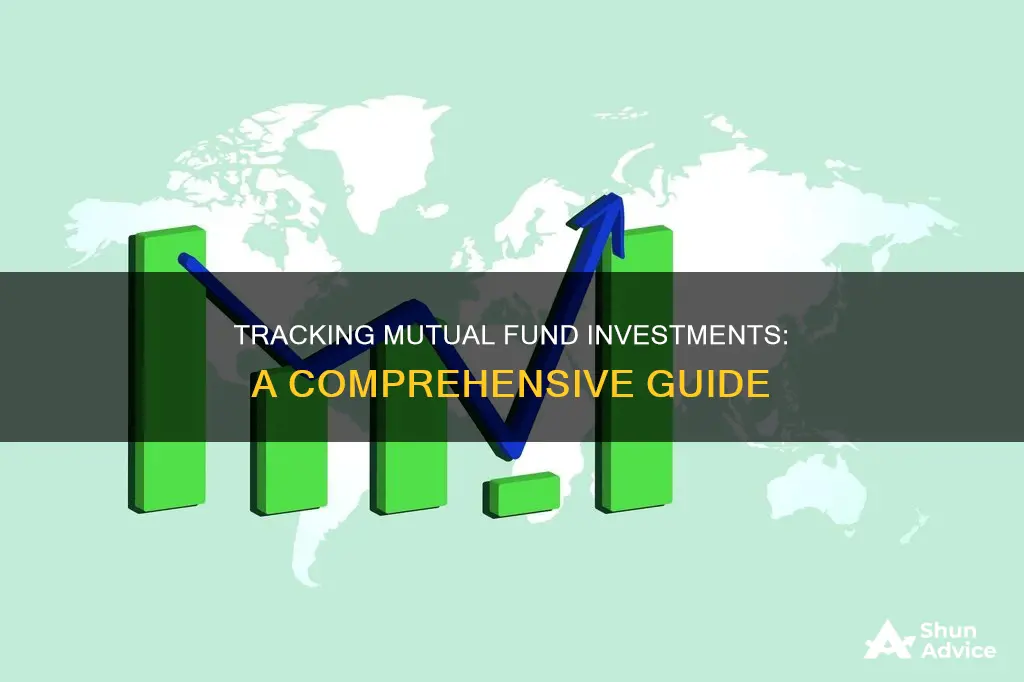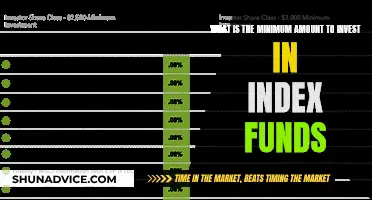
Tracking your mutual fund investments is essential to ensure you're on the right path to achieving your financial goals. It's like steering a ship – regularly checking your course keeps you headed in the right direction and helps you navigate the financial seas. While you should avoid making adjustments at short intervals, giving the scheme enough time to perform is crucial, especially if you've invested for the long term. However, how do you go about tracking your mutual fund investments? With the advancement of technology, several methods are now available to help you stay on top of your investments.
| Characteristics | Values |
|---|---|
| Purpose | To keep investors aware and up to date on the key facts of their fund |
| Frequency | Monthly |
| Format | One-page document |
| Content | Overview of a mutual fund scheme with special emphasis on disclosure of scheme performance and portfolio |
| Where to find | Mutual fund's website or by calling and requesting a copy |
| Readership | Average investor |
| Complementary documents | Mutual fund Scheme Information Document (SID) |
| Tracking tools | Consolidated Account Statement (CAS), AMC Website/Mobile App, Online Portfolio Trackers, Mutual Fund Fact Sheet, Investment Advisor |
What You'll Learn

Consolidated Account Statement (CAS)
The Consolidated Account Statement (CAS) is a consolidated statement that contains details of all the financial transactions performed in a month under the same PAN across fund houses and accounts/folios. The CAS is sent to the registered email/mail address of the investors, but it can also be accessed online. Here are the steps to access it online:
- Visit camsonline.com and click on 'MF Investors'.
- On the following page, choose 'CAS-CAMS' under the 'Statements' menu.
- Enter the email address registered in your mutual fund folio, PAN, and select the fund house.
- You can also choose a specific folio listing and the period for which you want the CAS statement.
- Choose a password that you will use to access the CAS you receive on your email address.
- You will receive the CAS on your email address in a password-protected file.
- Enter the same password to access your CAS.
The CAS is provided by CDSL (Central Depository Services Limited) or NSDL (National Securities Depository Limited) for months when there has been a financial transaction in the investor's mutual fund portfolio. It includes investments in equity shares, preference shares, mutual fund units, sovereign gold bonds, corporate bonds, debentures, securitized instruments, money market instruments, and government securities held in demat. It also includes details of mutual fund units kept in statement or folio form with different mutual fund companies. All investments held in single or joint names, with the investor as the sole/first holder, are part of the CAS.
The CAS is part of the vision to enable all financial assets to be held electronically in a single demat account. It offers convenience in keeping track of an investment portfolio, allowing investors to easily monitor the investments they hold, their value, and portfolio composition. The electronic version of CAS, or e-CAS, offers enhanced security and ease in storage and retrieval.
Angel Investment Fund: Getting Started as a Beginner
You may want to see also

AMC Website/Mobile App
Tracking your mutual fund investments is essential to ensure everything is on track and working as expected. Here are the steps you can follow to monitor your mutual fund investments using an AMC (Asset Management Company) website or mobile app:
Logging into Your Account:
Most AMCs now facilitate online investments in their mutual fund schemes. If you have invested digitally, you can log in to your account on the AMC's website or mobile app. This allows you easy access to your investment information.
Navigating to the Account Statement:
Once you have logged in, you can navigate to the account statement section. Here, you will find detailed information about your investments, including the amount invested, the funds chosen, and the date of investment.
Analyzing Portfolio Performance:
The account statement provides a comprehensive overview of your investment portfolio's performance. It includes information such as the returns generated, the current value of your investments, and any relevant updates or changes to your chosen funds. This information enables you to assess how your investments are performing over time.
Reviewing Fund Details:
Through the AMC website or app, you can review specific details about the mutual funds in your portfolio. This includes information such as the fund's investment objective, the fund manager's experience, the types of securities invested in, and the associated risks and returns. Understanding these details helps you make informed decisions about your investments.
Monitoring on a Regular Basis:
It is essential to regularly monitor your investments, especially if you have a long-term investment horizon. While short-term adjustments may not be necessary, regular tracking ensures that you are aware of any significant changes or issues. This proactive approach allows you to take timely action if needed and make any necessary adjustments to stay on track with your financial goals.
Utilizing Available Tools:
Some AMC platforms may offer additional tools to help you track and manage your investments more effectively. These could include features such as portfolio trackers, performance charts, or investment calculators. Utilizing these tools can provide a more detailed analysis of your investments and help you make more informed decisions.
By following these steps and utilizing the resources provided by the AMC, you can effectively track and manage your mutual fund investments through their website or mobile app. Remember to review your investments regularly and consider seeking advice from a qualified financial advisor to optimize your investment portfolio.
Invest in Abakkus Emerging Opportunities: A Guide
You may want to see also

Online Portfolio Trackers
Convenience and Accessibility
Consolidated Information
One of the key benefits of online portfolio trackers is their ability to consolidate information from multiple sources. If you have invested in mutual fund schemes from different fund houses, online trackers allow you to build a mock-up of your real mutual fund portfolio, bringing together schemes across various fund houses. This consolidated view makes it easier to track the performance of your investments in one place, rather than having to log in to multiple accounts.
Performance Tracking and Analysis
Portfolio trackers provide valuable insights into the performance of your mutual fund investments. They offer tools to help you analyze how your investments are doing, often with easy-to-read graphs and charts. Some trackers also allow you to compare your portfolio's performance against benchmark indices or other funds, helping you assess how your investments are faring relative to the market. Additionally, you can monitor factors such as asset allocation, risk levels, and fees associated with your investments.
Alerts and Notifications
Many online portfolio trackers offer alerts and notifications to keep you informed about significant changes or updates regarding your investments. You can set up alerts for price movements, news, earnings reports, and other financial information. This feature ensures that you receive timely updates without having to constantly monitor your portfolio.
Tax and Retirement Planning
Some portfolio trackers provide tax and retirement planning features. They can help you track retirement savings progress, create spending plans, and make informed decisions to meet your retirement goals. Additionally, certain trackers offer tax-related tools, such as taxable income reports, to assist with tax reporting and compliance.
Customization and Flexibility
Security and Privacy
Reputable online portfolio trackers prioritize the security and privacy of your financial information. They employ measures such as two-step remote authentication and encryption to protect your data. It is important to choose trackers that have robust security protocols in place to safeguard your sensitive financial details.
Examples of Online Portfolio Trackers
There are several online portfolio trackers available, including Empower (formerly Personal Capital), SigFig Wealth Management, Sharesight, and Yahoo Finance. Each tracker offers unique features and capabilities, and some cater to specific types of investors, such as international investors or dividend-focused investors. It is worth exploring the various options to find the one that best suits your needs.
Best Vanguard Funds for Your First Investment
You may want to see also

Mutual Fund Fact Sheet
A Mutual Fund Fact Sheet is a basic document that gives an overview of a mutual fund scheme. It is published monthly by each mutual fund and is accessible to the average investor. The fact sheet provides a concise summary of the fund's performance, fees, risk, and historical returns. It is a great starting point for potential investors to evaluate a mutual fund scheme before investing and for existing investors to track their fund's performance.
- Key Information about the Scheme: This includes the investment objective, name and experience of the fund manager, date of initial allotment, latest assets under management (AUM), and total expense ratio (TER).
- Investment in Securities: Details on the allocation of investments by sector and asset class.
- Quantitative/Volatility Measures: Standard deviation, beta, and Sharpe ratio for equity funds, and modified duration and average maturity for debt funds.
- Fund Performance/Returns: Reflects returns for both liquid and non-liquid funds, including the performance of the scheme relative to its benchmark.
- Risk Assessment: Information on the volatility and risk level associated with the fund.
- Fees and Expenses: Details on the fund's expense ratio and other fees.
- Minimum Investment Requirements: Information on the minimum investment amounts for initial and subsequent investments.
- Dividend Information: For income-focused funds, details on dividend yields, payout frequency, and historical dividend distributions.
- Manager Commentary: Additional insights from the fund manager on recent performance, changes in holdings or strategies, and the outlook based on market conditions.
- Glossary and Additional Information: A glossary of key terms and any important disclosures or caveats.
Where Can You Find a Mutual Fund Fact Sheet?
TSP Funds: Investing for the Future
You may want to see also

Investment Advisor
As an investment advisor, you can play a crucial role in helping your clients keep track of their mutual fund investments. Here are some ways to do this:
Offer Sound Financial Advice
Firstly, it is essential to understand that your role as an advisor is to partner with your clients in their investment journey. You can help them navigate the overwhelming amount of information available online and provide sound financial advice. This includes educating them about their investments and how to achieve their financial goals.
Help Clients Understand Mutual Fund Fact Sheets
Mutual fund fact sheets are basic one-page documents published monthly by each mutual fund. They provide an overview of the fund's performance, portfolio, investment objective, fund manager, latest assets under management (AUM), total expense ratio (TER), and risk assessment. These fact sheets are designed to be easily understood by the average investor. As an advisor, you can help your clients understand these fact sheets and make informed decisions about their investments.
Utilize Consolidated Account Statements (CAS)
Investors receive Consolidated Account Statements (CAS) from CDSL or NSDL when there has been a financial transaction in their mutual fund portfolio. CAS provides a consolidated view of all their mutual fund investments across fund houses for identical unit holders and accounts with financial activity during the month. As an advisor, you can help your clients understand and utilize these statements to track their investments.
Recommend Online Portfolio Trackers
If your clients have invested in multiple AMCs, you can suggest they use online portfolio trackers. These tools allow investors to build a mock-up of their real mutual fund portfolio with schemes across different fund houses. Online portfolio trackers can track the daily performance of their investments, providing a hassle-free and safe view of their portfolio.
Stay Up-to-Date with Market Trends
As an investment advisor, it is crucial to stay informed about the latest financial news and market trends. This enables you to provide relevant and timely advice to your clients. By analyzing market conditions, you can make informed recommendations regarding equities, debt funds, or money market instruments.
Regularly Review and Reassess Investment Strategies
It is important to review your clients' portfolios periodically to ensure they align with their financial goals, risk appetite, and investment time frame. If adjustments are needed, you can guide them through the process of modifying their investment strategies or diversifying their portfolios to minimize risks and maximize returns.
Remember, as an investment advisor, your role is to provide valuable insights and guidance to your clients. By staying informed, ethical, and dedicated to your clients' best interests, you can help them make the most of their mutual fund investments.
Invest in Fundsmith Equity Fund: A Comprehensive Guide
You may want to see also







